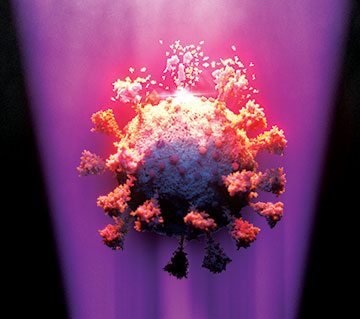
Artist’s conception of UV-C light degrading a particle of SARS-CoV-2, the coronavirus that causes COVID-19. [Image: University of Southampton]
Ultraviolet light kills germs―but how, exactly, do the shortest wavelengths of this spectral region wage war against the virus that caused the COVID-19 pandemic? Researchers in the United Kingdom say they have now provided a more complete picture of the damage that UV-C light wreaks on the proteins and genes of coronavirus particles.
Light with a wavelength of 266 nm supplies a double whammy: it damages the RNA inside the body of the coronavirus and degrades the proteins on the spikes that bind the virus particles to the enzymes inside the human body (ACS Photonics, doi:10.1021/acsphotonics.3c00828). Light at a wavelength of 227 nm inflicts less damage to coronavirus RNA but excels at oxidizing virus proteins.
“This tells us that there may need to be different UV disinfection strategies for different viruses and the possibility to tune the disinfection to either target certain pathogens or to render them non-infective as opposed to destroying them completely,” says Sumeet Mahajan, University of Southampton, UK, who led the study.
Disinfecting properties of light
The UV-A and UV-B components of sunlight stimulate vitamin D production in humans but also damage the DNA inside skin cells. Shorter-wavelength UV-C rays―between 280 and 200 nm―virtually never reach Earth due to the planet’s protective atmosphere. They are also less likely to penetrate human cells. Many proteins have an absorption peak around 230 nm, although the exact mechanisms of the interaction between virus proteins and radiation have not been fully understood. Thus, scientists have been keenly interested in the germicidal properties of that wavelength band.
Inside a biosafety level 3 laboratory to protect against disease transmission, Mahajan’s multidisciplinary team placed particles of the SARS-CoV-2 virus, which causes COVID-19, onto polystyrene surfaces and exposed them to irradiation from CW lasers operating at 227 and 226 nm. The researchers found that a 3-second dose of 75 mJ/cm2 from the 266-nm laser was enough to reduce the virus’s infectivity below the detection limit.
The researchers found that a 3-second dose of 75 mJ/cm2 from the 266-nm laser was enough to reduce the virus’s infectivity below the detection limit.
The group used methods such as polymerase chain reaction and Raman spectroscopy to assess the damage to the SARS-CoV-2 genome and the proteins that make up the virus. “Raman spectroscopy, a vibrational fingerprinting technique, provides a very high amount of molecular level information,” Mahajan says. “While it helped us see genomic damage too, it was the most insightful in providing us information on the damage to proteins, that they were undergoing conformational and structural changes. We confirmed the findings by UV-visible spectroscopy, gel electrophoresis and surface plasmon resonance, among others.”
Challenges and prospects
The biggest challenge the team faced, according to Mahajan, was adapting the biophotonics group’s equipment and techniques to working in a lab designed to protect both scientists and the outside world from virulent diseases. “It was a bit terrifying as well. knowing that we were working with something very deadly,” he adds.
According to Mahajan, the UV-C light disinfection strategy is suitable for killing off both airborne and surface particles, including those in hard-to-reach interior spaces. He says his team is eager to work with companies to incorporate UV-C sources into useful commercial disinfection products.
